Serviços Personalizados
Artigo
Indicadores
Links relacionados
-
 Citado por Google
Citado por Google -
 Similares em Google
Similares em Google
Compartilhar
Journal of the South African Institution of Civil Engineering
versão On-line ISSN 2309-8775
versão impressa ISSN 1021-2019
J. S. Afr. Inst. Civ. Eng. vol.51 no.1 Midrand Abr. 2009
TECHNICAL PAPER
Practical implications of the relation between the clay mineral content and the Plasticity Index of dolerite road construction material
E Kleyn; A Bergh; P Botha
ABSTRACT
Naturally occurring road building materials, suitable for the higher-quality upper strata of road pavements (base and subbase layers), are systematically being depleted, resulting in the haulage of alternative material over increasing distances or the introduction of more expensive commercially manufactured materials. For this reason the naturally occurring materials have to be better assessed and utilised. The weathered rock most widely used for road construction in South Africa, yet also notorious for its variability and propensity to marginal behaviour, is dolerite. Tests developed for assessing the suitability of road building materials have, in the case of dolerite, often misled design engineers and technicians, to the point that the material is rather avoided if there is any suspicion of its quality being marginal. If the behaviour of dolerite under various environmental conditions were to be better understood, the assessment tests might also be improved, as well as being more effectively applied. This paper deals with the findings and recommendations resulting from research in this regard, especially the relationship between the Plasticity Index (PI) and the smectite content of dolerites in areas where the Weinert N-value is below 3, and its implications. It was found that there is a distinct correlation between the PI of decomposed dolerite gravel and its smectite content, and also that using the minus 0,425 mm material for the standard PI test does not adequately expose the smectite in freshly crushed dolerite rock. A rational explanation is presented for the short-term decomposition of stockpiled weathered dolerite. The results of this investigation indicate that for optimum durability, even dolerite gravel with a barely measurable smectite content should be treated (i.e. with lime) when used for base and subbase layers, and crushed dolerite rock intended for Crushed Rock (G1) base should be treated similarly.
Keywords: dolente, smectite, X-ray diffraction, Plasticity Index, basecourse
INTRODUCTION
The pavement design of a road is responsible for its structural capacity and integrity which largely govern the achievement and sustainability of the functional objectives of the route (COLTO 1996). Local rock in its various stages of decomposition is utilised as road building material, necessitating an understanding of its basic composition and behaviour in order for it to be effectively applied (Weinert 1980; Du Toit 1956).
The South African pavement design philosophy was developed around the principle of optimum utilisation of local rock and gravel materials (Kleyn 1955; TPA Roads Branch 1970; Kleyn 1989). This has been possible largely due to the availability of relatively high-quality local materials in South Africa. It has resulted in less-expensive pavement compositions being achievable than in many overseas countries where greater use is made of oil-based bituminous pavement layers.
However, naturally occurring road building materials suitable for the higher-quality upper strata of road pavements (base and subbase layers) are systematically being depleted, resulting in the haulage of alternative materials over increasing distances or the introduction of more expensive commercially manufactured (i. e. crushed) materials, thus negating the basis of the local pavement design philosophy. For this reason the naturally occurring materials have to be better assessed for their effective utilisation.
The weathered rock most widely used for road construction purposes in South Africa, yet also notorious for its variability and propensity to marginal behaviour, is dolerite. The tests developed for assessing the suitability of road building materials (TMH1 1986) have, in the case of dolerite, often misled design engineers and technicians, to the point that the material is rather avoided if there is any suspicion of its quality being marginal. If the behaviour of dolerite under various environmental conditions were to be better understood, the assessment tests might also be improved, as well as more effectively applied. This, coupled with improved construction specifications, should lead to more cost-effective utilisation of our natural resources.
This paper deals with the findings and recommendations resulting from research in this regard, especially the relationship between the Plasticity Index (PI) and the smectite content of dolerites in areas where the Weinert N-value is below 3, and its implications.
INVESTIGATION
Difficulties with dolerite
Durability is the principal consideration for road building material since all other engineering properties are, to a greater or lesser degree, affected by it. Poor durability could negate all other engineering parameters and specifications (e.g. bearing capacity, strength, density, moisture sensitivity, etc.) before the road has seen much service. In this regard valuable work was done by Sampson and Netterberg (1989), which resulted in the Durability Mill Index test and guidelines.
Because of its mineralogical composition, dolerite can exhibit very variable weathering and non-optimal behaviour once exposed and/or used for road construction. This has given rise to an assortment of assessment tests and precautionary measures. However, as noted by Paige-Green (2007), determining and specifying reliable limiting values have proved very difficult.
The cited difficulties regarding dolerites are allegedly one or more of the following:
Stockpiled crushed material exhibiting an increase in PI when retested at a later stage
Layered gravel material decomposing to clay in spite of careful initial selection
Development of plasticity in a layer of Crushed Stone base (G1) and resultant failure
These difficulties have occurred even when the original PIs obtained were lower, i.e. from 2 to 4, using the standard test method (TMH 1 1986) on the minus 0,425 mm material.
Since it is well known that certain minerals in rock are primarily responsible for the production of clay when the material decomposes, especially basic crystalline rock such as dolerite (Du Toit 1956), it was decided to investigate whether there is a usable correlation between the PI and the smectite content of dolerite and, if so, whether it is possible to develop such a correlation as a potential durability assessment tool.
Sampling and testing
As a first phase the dolerite samples used in this investigation were all gathered in areas where the Weinert N-value (1980) is below 3 - the eastern parts of the Free State, the Gauteng/Mpumalanga border and southern Mpumalanga, all in or close to the moisture-surplus areas where climatic conditions favour chemical decomposition. The samples were collected from visually different zones in existing borrow pits and quarries. Some samples were classified (Weinert 1980) as highly decomposed (soft doleritic natural road building gravel), while others were classified as relatively fresh rock (hard dolerite requiring mechanical breakdown to be useable for road building purposes). Figures 1 and 2 show examples of natural dolerite gravel and crushed dolerite rock respectively, for the purpose of this investigation.
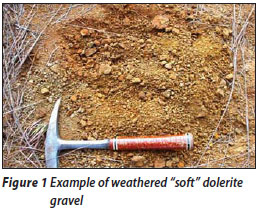
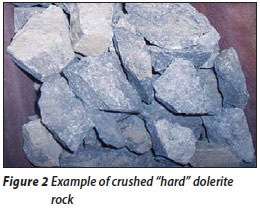
All the samples were subjected to standard PI determination tests (TMH1 1986) at the CSIR, as well as semi-quantitative X-ray diffraction analyses carried out by the Council for Geoscience in Pretoria (to determine the mineralogical composition). Thereafter the estimated percentage of the smectite clay mineral component (Weinert 1980; Kirsch 1968) of each sample was plotted graphically against its corresponding PI. The relatively fresh dolerite samples were crushed and the standard PI tests performed on the minus 0,425 mm material. (In most cases the fresh dolerites registered non-plasticity, as would be expected.)
Initial results
Figure 3 illustrates that the test results tend to show two groupings: the naturally decomposed dolerite (road building gravel) in which extensive chemical reaction/decomposition has taken place resulting in significant PIs, and the relatively fresh crushed dolerite (rock) having zero or negligible PI. It seems most unlikely that any weathered dolerite gravel having a PI of less than 4 to 6 would be present in the areas investigated - relegating these materials to a classification of "troublesome" or "marginal" as far as base and subbase application goes. Accordingly, these materials should rather be avoided - unless the materials engineers or technicians have had practical experience with dolerite gravel and understand the technology of treating the material with lime (Cartmell & Bergh 1958; Ballantine & Rossouw 1989). From Figure 3 it can also be inferred that the dolerite rock is sound with regard to its PI and should be durable for use as surfacing aggregate and Crushed Stone (G1) base. Unfortunately, this approach has led to some premature failures in the past, as mentioned above, and to dolerite increasingly being avoided for this type of application.
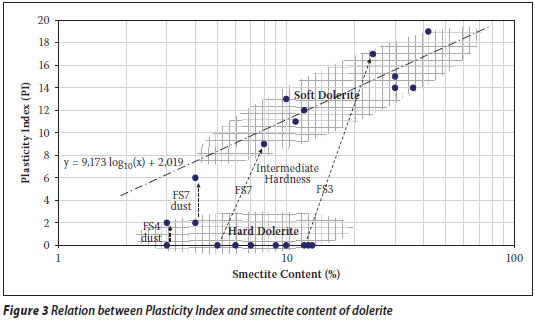
DISCUSSION
Dolerites have been subjected to alteration during their cooling and crystallisation by the vapours and volatiles produced by the magma itself permeating the cooling rock mass. Some of the primary minerals in the rock then alter partly to the active clay smectite. These clay minerals are highly sensitive to moisture, resulting in a pronounced lowering of the bearing capacity of the gravel as it becomes wetter.
Normally in nature, the decomposition and conversion occur on a geological time scale over many millennia. This being the case, one would expect the PI of the fresh dolerite rock (aligned along the X-axis) to move towards alignment with the decomposed dolerite gravel with the passing of time. The arrow-line sets FS3 and FS7 in Figure 3 are shown as examples of this natural occurrence within the same dolerite quarry. Each arrow-line represents the "weathering path" followed by the material in that quarry when it decomposed from fresh rock to natural gravel, based on samples taken from the lower strata (hard dolerite rock) and from the decomposed surface gravel of the quarries (from which the fines had not been washed out). These sets also validate the accepted fact that as dolerite decomposes, the PI of the material increases and its ratio of PI to smectite moves in the direction of the ratio exhibited by the decomposed dolerite gravel, shown in Figure 3 (this is not necessarily the only ratio, but is the one found for dolerite in the eastern parts of Gauteng, Mpumalanga and the Free State where N is below 3). Note that if allowed to follow its natural course, even a small smectite content would eventually result in dolerite gravel with PI levels and moisture sensitivity that are unacceptable for untreated application in road bases and subbases.
When the material is excavated and crushed, the clay minerals become more readily exposed to the atmosphere and the effect of moisture during either laboratory testing or construction work. In other words, aggressive handling of the material can break it down further and expose more of the clay minerals for participation in the chemical or moisture reactions. It thus seems likely that if the standard preparatory mixing time for dolerite PI samples were to be extended, an increased PI value will result.
This reasoning could also account for the observation that although the laboratory-determined PI of stockpiled, crushed fresh dolerite may be negligible for practical purposes, it is sometimes obvious to the trained eye that the fines on the surface of a crushed dolerite stockpile show definite signs of having some PI, as evidenced by a visible dust-crust on the stockpiled material. (Before assigning this cause to the above-mentioned phenomenon, however, one should also assess the possibility of contamination of the parent fresh material during crushing. Overburden that has not been effectively removed during the winning and crushing process, as well as wind-blown overburden dust, can also be the cause.)
ADDITIONAL INVESTIGATION: THE EFFECT OF MIXING TIME ON THE PLASTICITY INDEX
With the above in mind, it was decided to review the sensitivity of dolerite (in terms of PI registration) to test sample preparatory mixing time by determining the PI of dolerite samples according to the standard test method, as well as after extended mixing times. Figure 4 shows the general trend found.
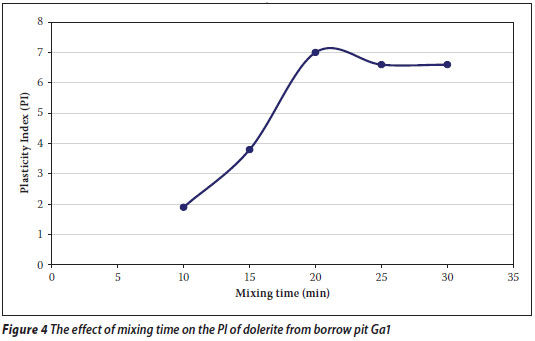
Note that a three-and-a-half-fold increase in PI resulted in this particular case when the mixing time was increased from 10 to 20 minutes, after which the change levelled off again. The conclusion is that extending the mixing time can substantially increase the PI and that the cautions regarding dolerite introduced by materials engineers and technicians over the years seem to be well founded - dolerite is sensitive to manhandling. This finding is in agreement with that of previous investigations (Weinert 1964). However, the results of the investigation reported in this paper represent substantial progress regarding the road building application since then. (Note that 20 minutes' mixing might not necessarily deliver the optimum PI results for design purposes in all cases and further work in this respect is still necessary.)
ADDITIONAL INVESTIGATION: THE EFFECT OF PARTICLE SIZE ON THE PLASTICITY INDEX
It was also decided to investigate the effect of particle size (grading fraction) on the PI test results, based on the reasoning that the finer the rock particles are crushed, the more the clay-forming minerals and existing clays would be exposed to the detrimental effect of the environment and moisture, and that the better soils tests should register their presence.
Fines at two quarries were sampled - one where a dust-crust was not visible and the other (exposed to the elements for about three months) where it was present. The PIs on the minus 0,425 mm material and the minus 0,075 mm material were determined. The general trend resulting from this investigation is shown in Table 1. There is a significant increase in PI when the finer fraction of the grading is tested, even with relatively fresh dolerite with a low smectite content - that is the material usually used in practice without question. Mineralogical analyses were done on the samples as before, and the results are also plotted in Figure 3 as weathering path sets FS4 and FS7.
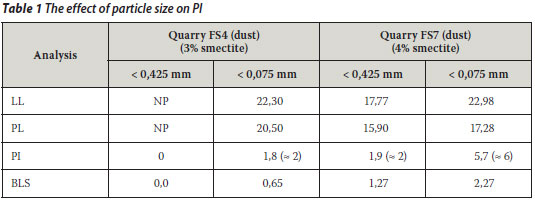
From the above examples it is clear that increasing the mixing time (breaking down the material) and testing the finer material results in the test registering the presence of clay minerals (now physically more exposed) better - dramatically affecting the PI. This short-term result aligns well with the decomposition principle illustrated by the weathering paths FS3 and FS7 in Figure 3. It is important to note that although the smectite content of the "hard" dolerite increased as it decomposed to "soft" dolerite (as indicated by the long-term weathering paths FS3 and FS7), the short-term artificial weathering (represented by weathering paths FS4 and FS7) does not result in an increase in smectite content. This suggests that dolerite does not decompose and degenerate into clay in the short term, as currently believed, but rather that it weathers mechanically, increasingly exposing the inherent clay minerals and resulting in an increase in the PI (of the fine component) of the gravel. The indication is that "soft" dolerite gravel with a smectite content above 3% could have a PI of more than 6, which would require lime treatment if it was used for base or subbase. The situation is similar for dolerite rock intended for Crushed Stone base aggregate, because of the possibility of in-service generation of fines due to aggregate-to-aggregate abrasion and consequent exposure of the inherent clay minerals. This seems to align with the findings of Sampson and Netterberg (1989) that "...the maximum allowable PI should be reduced to five for good to fair performance and to four for good performance" for natural gravel bases.
The often surprising behaviour of dolerite observed in the past is better understood now, enabling the materials engineer or technician to control the behaviour of dolerite material better. It may seem that increasing the sensitivity of the PI test should lead to more dolerite material being rejected as substandard, but it is our contention that the opposite will happen. If the PI (moisture sensitivity) and durability of dolerite can be assessed and determined with ease and more accuracy, the existing knowledge and technology of lime treatment could be applied timeously during pavement design or construction, resulting in an improvement in the prediction of behaviour and overall performance. (In order to obtain a fuller picture, this investigation should be extended to dolerites in drier areas where the Weinert N-value is higher than in the areas used for this investigation.)
CONCLUSIONS AND RECOMMENDATIONS
There is a distinct correlation between the Plasticity Index (PI) of decomposed dolerite gravel and its smectite content. This affords a practical indicator of the PI that can be expected to develop when the material decomposes to a road building gravel, and it may be utilised in conjunction with other assessment procedures in this field, such as the Durability Mill Index (Sampson and Netterberg 1989; Paige-Green 2007).
It is quite clear that dolerite road building gravel having a standard PI of less than 6 would be rare in the eastern parts of Gauteng, Mpumalanga and the Free State. This could lead to construction material prospectors turning to more expensive, commercially produced material for base and subbase material, especially if the technology of pretreatment or stabilisation of dolerite material with lime is not understood and applied - causing an artificial scarcity of road building material in these areas.
Using the minus 0,425 mm material for the standard PI test does not adequately expose the smectite in freshly crushed dolerite rock to the influence of the testing procedure, resulting in an optimistic PI value. This does not offer adequate sensitivity or warning regarding the road building-related durability of the material. The sensitivity of the test on dolerite can be improved by increasing the sample mixing time and by decreasing the particle size of the test sample (20 minutes' mixing time on minus 0,075 mm material in this case) - a valuable comparative indicator test if done in conjunction with the standard PI test.
The results of this investigation present a rational explanation for what were, up to now, speculatively considered by many to be the short-term decomposition of stockpiled weathered dolerite. What is responsible for the apparent rapid deterioration of the material does not seem to be accelerated chemical decomposition of the dolerite minerals per se, but rather the mechanical exposure and the subsequent release of the existing clay minerals in the dolerite to participate in the measurement of the PI and the harsh operating environment of a road pavement.
The results of this investigation indicate that for optimum durability, even dolerite gravel with a barely measurable smectite content should be treated (with lime) when used for base and subbase layers, and similarly for crushed dolerite rock intended for Crushed Rock (G1) base.
It is suggested that the application of the above findings (even though further investigations are recommended) could assist in the identification and utilisation of dolerite deposits for more cost-effective road building application. The moisture sensitivity and durability of dolerite materials in areas where the Weinert N-value is low (< 3) may now be assessed with increased understanding. This will allow the material, treated as considered necessary, to be used for road pavement construction with more confidence and predictability than before.
REFERENCES
Ballantine, R W and Rossouw, A J 1989. Stabilisation of soils. Johannesburg: PPC Lime Ltd. [ Links ]
Cartmell, H S and Bergh, A O 1958. Lime stabilization of soils for use as road foundations in Northern Rhodesia. Road Research Laboratory Overseas Bulletin No. 9, Department of Scientific and Industrial Research, Harmondsworth, Middlesex, England. [ Links ]
COLTO (Committee of Land Transport Officials) 1996. Structural design of flexible pavements for interurban and rural roads. Draft TRH 4, Pretoria: Department of Transport. [ Links ]
Du Toit, A L 1956. The geology of South Africa. Edinburgh: Oliver and Boyd. [ Links ]
Kirsch, H 1968. Applied mineralogy for engineers, technologists and students. UK: Chapman & Hall. [ Links ]
Kleyn, E G 1989. The development of an equation for the strength-balance of road pavement structures. The Civil Engineer in South Africa: Transactions of the South African Institution of Civil Engineers, Feb 1989. [ Links ]
Kleyn, S A 1955. Possible developments in pavement design. Transactions of the South African Institution of Civil Engineers, Sept 1955. [ Links ]
Paige-Green, P 2007. Durability testing of basic crystalline rocks and specification for use as road base aggregate. Bulletin of Engineering Geologists and the Environment, 66:431-440. [ Links ]
Sampson, L R and Netterberg, F 1989. The Durability Mill: A new performance-related durability test for basecourse aggregates. The Civil Engineer in South Africa, Sept 1989. [ Links ]
TMH1 1986. Standard methods of testing road construction materials. Pretoria: CSIR. [ Links ]
TPA Roads Branch 1970. Plaveiselontwerp handleiding (Pavement design manual). Manual L1/70, Pretoria: Transvaal Roads Department. [ Links ]
Weinert, H H 1964. Basic igneous rocks in road foundations. NIRR Bulletin No. 5, Pretoria: CSIR. [ Links ]
Weinert, H H 1980. The natural road construction materials of South Africa. Cape Town: H&R Academica. [ Links ]
 | EDUARD KLEYN retired from a career with the former Transvaal Provincial Administration Roads Department in 1995 after 32 years' service in the various directorates, including the former Eastern Transvaal Region. He spent the greater part of his career heading the Directorate: Materials at the Provincial Soils Laboratory in Pretoria. During thlstime he inter alia piloted the development of the Dynamic Cone Penetrometer (DCP) for road pavement application, the Road Network Management System (RNMS) and the Heavy Vehicle Simulator (HVS) programme of the former TPA Roads Department. He was author or co-author of numerous papers and manuals in this regard. He was a consultant to the CSIR's Built Environment unit in Pretoria unti mid-2008 and is at present operating as a private consultant. |
 | ADRIAN BERGH Is a civil engineer with extensive experience in roads engineering In the public and contracting sectors, and as a consulting engineer. His expertise lies In the fields of Tialntenanceand rehabilitation of gravel anc olacktop roads, with his special Interest being lr the application of bituminous seals. He has appeared as an expert witness on a number of occasions on disputes relating to road materials and surfaclngs, and has served on various subcommittees regarding surfacing work. He is a consultant to the CSIR Built Environment unit in the areas of appropriate technology relating to the creation of employment opportunities in the construction of low-volume surfaced roads and the rehabilitation and maintenance of gravel and surfaced roads. |
 | Sadly, PIETER BOTHA passed away during August 2007. He was a Civil Engineering Technician with a contagious affinity for and knowledge of road building materials, as witnessed by numerous publications, reports and his co-workers alike. Notably, he assisted contractors to appreciate and overcome the finer intricacies of "stubborn" construction materials. Pieter started his career with the Cape Provincial Administration in 1968 where he progressed to Senior Technician before transferring to the Department of Transport in Pretoria in 1976, where he progressed to Contro Technician before moving on to CSIR Transportek in 1998 to eventually become a Technical Researcher in the CSIR Built Environment unit. |
 Contact details:
Contact details:
CSIR Built Environment
PO Box 395
Pretoria, 0001
T 012 841 338. F 012 841 3539
ekleyn@ffg.net
Contact details:
CSIR Built Environment
PO Box 395
Pretoria, 0001
T 012 841 3381. F 012 841 3539














